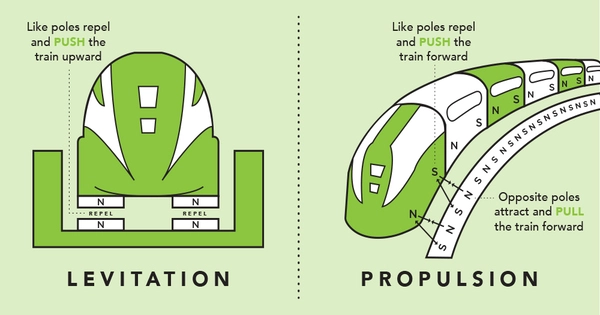Maglev (from magnetic levitation) is a train transportation system that employs two sets of electromagnets: one to repel and push the train up off the track, and another to move the elevated train ahead, taking advantage of the lack of friction. It has several advantages over traditional transportation systems, such as lower friction, higher speed potential, and smoother rides.
The vehicle in a maglev system is suspended above the track by powerful magnets that create a repulsive force between the vehicle and the track. Because of this repulsion, the vehicle can float above the track, eliminating friction and allowing for high-speed travel with minimal energy loss. Because there is no physical contact between the vehicle and the track, wear and tear is reduced, resulting in lower maintenance costs.
These trains rise about 10 centimetres (4 in) off the track. High-speed intercity maglev systems (over 400 kilometres per hour or 250 miles per hour) and low-speed urban maglev systems (80-200 kilometres per hour or 50-124 miles per hour) are being built or are in the planning stages.
With maglev technology, the train travels along an electromagnet guideway that controls the train’s stability and speed. While propulsion and levitation have no moving parts, the bogies can move in relation to the main body of the vehicle, and some technologies require retractable wheels at speeds less than 150 kilometers per hour (93 miles per hour).
There are two main types of maglev technology: electromagnetic suspension (EMS) and electrodynamic suspension (EDS).
- Electromagnetic Suspension (EMS): The vehicle in an EMS system is levitated and propelled by electromagnetic coils mounted on the vehicle and the track. These coils generate a magnetic field that interacts with one another, causing the vehicle to hover and move along the track. The vehicle can be lifted or lowered by adjusting the currents in the coils, allowing for precise control.
- Electrodynamic Suspension (EDS): Superconducting magnets on the vehicle and a conducting track are used in EDS systems. When cooled to a very low temperature, a superconductor has zero electrical resistance and can generate strong magnetic fields. The interaction of the superconducting magnets and the conducting track induces currents in the track, resulting in a repulsive force that lifts the vehicle. By varying the strength of the magnetic field, the vehicle’s height and stability can be controlled.
Because there are no bumps or vibrations caused by the wheels rolling on the track, maglev systems are known for providing smoother rides than traditional rail systems. This can improve passenger comfort while also lowering the risk of motion sickness. This is in contrast to electric multiple units, which may have several dozen parts per bogie. Maglev trains can thus be quieter and smoother than conventional trains in some cases, and have the potential for much higher speeds.
















